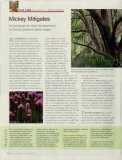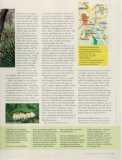As a consequence of population growth and resource development, many wetlands that once existed in the United States have been drained or otherwise destroyed. In the past half century, however, local, state, and national initiatives have sought to slow down the loss. Perhaps most notably, as written and amended in the 1970s, Section 404 of the Federal Water Pollution Control Act, commonly known as the Clean Water Act, has guided the protection of surviving wetlands, which may not be altered or destroyed without a permit issued by the United States Army Corps of Engineers. To obtain a permit, a private or public owner must first show that impacts on wetlands have been avoided or minimized where possible. If some losses appear unavoidable, an owner may negotiate to "mitigate" (offset) the effects by restoring or creating wetland somewhere else.
Often many small wetland areas are created or restored in exchange for one large tract, but a successful initiative in central Florida took a different tack. During the 1980s, the Walt Disney World Company wanted to develop an additional 11,000 acres — including about 600 acres of wetland — within its vast complex of land. Coincidentally, the 8,500-acre Walker Ranch, about fifteen miles south of Walt Disney World, was under consideration for residential development, to include up to 9,000 homes, six golf courses, and a marina. Threatened and endangered species that lived on the ranch stood to lose. The Florida Audubon Society urged that, as a mitigation project, the ranch site be restored to its original natural conditions, including substantial wetlands. In 1991 the Walt Disney World Company offered to undertake just such a project in exchange for its own development. All the required government agencies signed on, and The Nature Conservancy was asked to develop a restoration plan and oversee its implementation.
Walt Disney World spent nearly $45 million to purchase Walker Ranch and to pay for habitat restoration, including the re-creation of substantial wetlands, through the year 2012. At the end of 1992, the land was turned over to The Nature Conservancy. Ultimately, more than 3,000 additional private and public acres were added to the tract, now known as The Nature Conservancy's Disney Wilderness Preserve.
The preserve property has a varied past. From 1926 to 1979 it belonged to the Candler Lumber Company (Asa Candler also founded the Coca-Cola Company). Throughout that time local cypress trees were logged extensively for timber production, and into the 1940s many ot the pines were damaged or destroyed by tapping for turpentine. Open-range ranching of "scrub cows" was practiced until Florida's fence law was passed in 1949, after which more intensive cattle ranching began to have a major impact on the land. To increase grazing acreage, drainage ditches and canals were dug, which lowered the water table significantly — a trend that reached its culmination under Walker ownership after 1979. Nevertheless, the tract still harbored much native wildlife and many remnants of its original plant communities.
Today, the eighteen-year-old preserve is already a showcase for the results of knowledgeable restoration and management practices. There are now good examples of a whole host of habitats. One is mesic (moist) flat-woods, also known in Florida as pine flatwoods or pine savanna, where widely spaced longleaf pine trees and a scattering of slash pine trees form an open canopy above a continuous ground cover of grasses, wildflowers, and shrubs. That habitat's flat terrain is usually poorly drained because a hardpan of clay underlies the acidic, sandy soil. At slightly higher elevations, where a substrate of white sand permits rapid drainage, is an oak scrub with several species of dwarf, evergreen oaks. In between is a transitional zone, scrubby flatwoods, with both pine and oak.
The approximately 4,000 acres of wetlands, featured in the habitats listed below, include wet prairie, a flat, treeless habitat with relatively poorly drained soil that is a mixture of fine sand and organic matter. Occurring wherever the land dips slightly below the elevation of the flatwoods — in depressions and around the rims of marshes and swamps — wet prairie is inundated for two to five months each year, yet can become quite dry during the rain-poor winter.
Mesic hammock, whose occasionally inundated, poorly drained soil consists of fine sands with some organic content, supports a fairly closed canopy of live oak and other trees. Floodplain marsh, found adjacent to streams, has primarily sandy alluvial soils that are frequently inundated by river flooding. Floodplain swamp, however, is flooded to varying depths for most of the year. Found along the edges of Lake Russell, as well as along streamchannels, it supports cypress and other water-tolerant trees. Bayhead — a densely forested, fire-resistant community dominated by several species of bay trees — occurs in peat-filled depressions.
The diverse habitats are favored by protected species of birds and other animals. Among them are bald eagles (mesic flatwoods), Florida scrub jays (oak scrub), wood storks (floodplain swamp), and gopher tortoises (scrubby flatwoods). Visitors can start their tour at the Conservation Learning Center — headquarters for both public information and conservation research — and then venture forth on a hiking trail. Covering a 2.2-mile loop, the trail offers a close look at the preserve's natural communities of plants and animals. Or one can take the trail just as far as Lake Russell, a one-mile round trip to view one of the last remaining pristine lakes in central Florida.

